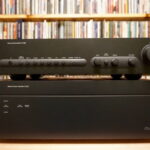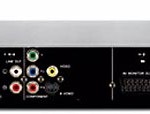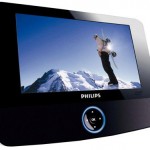Norwegian AV guru ProjectionDesign delivers DLP’s next ‘full HD’ projector. The SmartHouse Team looks on in pure admiration.

With both HD DVD and Blu-ray discs delivering their first movies in 1080i/p, serious AV enthusiasts – like ourselves! – are being drawn ever more towards display devices with native pixel counts of 1920 x 1080. So it's fair to say that we were seriously excited by the arrival of the Action Model Three 1080: the second 1080p DLP projector to arrive at the doors of SmartHouse, following the SIM2 HT3000.
It's actually a surprise SIM2 hit our pages first, since, for a long time during the two projectors' development, projectiondesign seemed to be slightly ahead of the opposition. But ultimately the extra complexities of the PD model – it does, after all, cost six grand more than the SIM2 – seems to have lost them the top slot.
Actually, now we've mentioned the Model Three 1080's price – all $41,750 with a Standard 1.6 to 2.3:1 lens and VPS33000 scaler– it probably makes sense to try and explain just why PD thinks its projector is really worth that much.

Features
Actually manufacturing a 1920 x 1080 native DLP chipset is a wee bit tricky – not surprising when you consider that such a device needs to fit over two million independently controllable mirrors onto the back of a single controlling chipset. But of course, SIM2's cheaper 1080 DLP model uses the same chipset, so that alone can't explain the price.
So for more justification, let's turn to the Model Three 1080's second box. For yes, even though it's one of the chunkiest projectors around (the exact opposite of PD's usually strikingly diminutive projectors), it still can't fit in all the processing PD wanted to provide with its single-chip flagship. {mospagebreak}
This second control/processing/connections box tellingly comes badged with the words Crystalio II, the name for a box of tricks from Pixel Magic that's respected the world over for its image processing talents, driven by the Gennum VXP video scaling system (or the Faroudja DCDi process, which is also included).
The inclusion of this processor shows how important it is to PD that you get the best out of the Action Model Three 1080. For the Crystalio box can take in any video signal, of any resolution, and upconvert it to 1080p before feeding it via a digital output to the 1080-hungry Model Three's optics. The key explanation for the PD's hefty price tag, though, is the fact that it uses two lamps and two separate 7-segment DLP colour wheels/light formatters.
This phenomenally complex dual light approach is made possible by PD's patented DuArch technology, and should result in outstanding contrast and brightness, as well as far greater control over brightness levels since both lamps can be controlled separately.
To put some numbers on this, the projector claims a ‘true optical' contrast ratio of 7,500:1, and a maximum brightness potential right up to 2500 ANSI Lumens (making it capable of driving truly immense screen sizes).
We could harp on for pages about all the fancy shenanigans going on inside the Model Three 1080, and especially the Crystalio box. But we'll content ourselves to a mention of Texas Instrument's new Spoke Light Recapture technology for improving colour reproduction, especially in secondary colours; and more colour improvement from PD's own RealColour colour management system.
The Crystalio box is positively oozing with connections, including four HDMI inputs, four component inputs, PC BNC inputs, two SDI inputs, USB and Ethernet ports. And we should also add that the projector can be bought with any of six different lenses, ranging from an ultra-wide angle 0.79:1 for near projection to the super tele-zoom at 3.8-6.5:1.
Performance
As we fire the Model Three 1080 up, we can't help but wonder if PD really has managed to nail the combination of high-end third-party processing, new DMD chipset, and DuArch technology so soon. Happily, such concerns are immediately squashed, as the Model Three 1080 produces a picture quality that's extraordinarily good.
The fine detail and texture displayed in the image is nothing short of revelatory, with the projector regularly showing minute elements in our favourite 1080i HD sources that we didn't even realise were there before.
Part of this astounding clarity is doubtless down to the sheer pixel count that the Model Three's image contains. But credit must also go to the remarkable lack of noise that's visible in the picture, which dramatically proves both the benefits of a) matching the native DMD resolution to the source image's native resolution, and b) the considerable prowess of the Crystalio II processing engine.
Yet more proof of just how good – and intelligent – every element of the Model Three 1080's optics and processing is can be seen in the way it clearly reveals the difference (in terms of stability and even more texture) of between 1080p and 1080i sources.
Incred ibly though, it's not just high-def's friend. The Crystalio box also does a mind-bogglingly good job of upscaling standard-definition sources – anything above a composite feed, anyway – to fit the projector's 1080p preference. The SIM2 excelled in this regard, but we'd argue the PD is even slightly better.
Also setting the Model Three 1080 apart is its DuArch-inspired combination of extreme brightness and hugely expansive contrast – a combination which aids the projector in producing richer, more detailed and more subtly greyscaled dark areas than we've ever seen before, certainly on a single-chip projector.
The trouble projectiondesign has gone to in the name of colours pays off handsomely too, with a pretty much picture perfect palette with all types of source image.
The only downers we could see with this projector are minor. First, the need for two colour wheels, and to cool two separate lamps, means the unit makes quite a whirring noise, and second, fast moving objects occasionally look fractionally indistinct. Though this is true to some extent, of course, with all DLP models.
However, in regards to the noise, Rod Sommerich of the product's Australian distributor, Amber Technology, says if you only use one lamp, then the colourwheel also stops turning so you will notice a reduction on the unit's noise.

Conclusion
It might be big, expensive and even ugly, but the best way to sum up the Model Three 1080 is to say that it really does deliver the closest experience to actually going to a good commercial cinema that we have yet seen – only without the usual scratches and dirt specks over the picture! In fact, Sommerich says projectiondesign has begun delivering over 800 projectors to all cinemas in Scandinavia for E-Cinema use, and in Australia, Amber has delivered a number of units to major post production facilities for colour grading and editing use and to an Australian television network for program monitoring in their main presentation control rooms. Several of the 720P version of the product are in commercial cinemas in Australia and New Zealand also.
Overall, this projector is an excellent ambassador for 1080p high-definition.
| Specifications
display |
|
| technology | 0.95" 1080p DC3™ single chip DLP™ technolgy |
| concept | powered lens shift design |
| colour wheel options | |
| resolution | 1920 x 1080 pixels |
| brightness | 500 – 2500 lumens, user adjustable |
| contrast | about 7500 : 1 (max, on/off) |
| aspect ratio | 16 : 9, 4 : 3 compatible |
| displayable colours | 16.8 Million colours, 24-bit RGB |
| image processing latency | ~1 frame on graphics port |
| compatibility | |
| computer compatibility | Custom modes: 47.94, 48, 50, 59.94, 60 Hz, 1920 x 1080 |
| horizontal scan frequency | n/a |
| vertical scan frequency | 47.94 – 60 Hz |
| video compatibility | 1080p |
| optics | |
| standard projection lens | f= 32.5 mm – 49 mm, F/2.1 – 6.1 (adjustable) |
| throw ratio | 1.6 – 2.32: 1 (EN11) |
| image size (diagonal) | 30 – 600 |
| focusing distance | 2 – 30m / 5 – 100 ft |
| ultra wide angle lens | 0.79 : 1 fixed focal, on axis (EN12) |
| wide angle lens | 1.16 : 1 fixed focal (EN15) |
| wide angle zoom | 1.24 – 1.6 : 1 (EN13) |
| short tele zoom | 2.37 – 3.79 : 1 (EN14) |
| long tele zoom | 3.8 – 6.5 : 1 (EN16) |
| lamp | 2x 200 – 250W UHP™, user adjustable power |
| lamp life | 2000 hours full power (max) |
| 8000 hours, eco relay mode (max) |
|
| inputs / outputs | |
| computer input(s) | DVI-D (HDCP) |
| video input(s) | DVI (HDCP) |
| audio input(s) | n/a |
| control and communcation | 9-pin DSUB RS232 bus in/out |
| USB | |
| TCP/IP (RJ45) |
|
| Wired and IR remote control |
|
| monitor redrive | n/a |
| audio output | n/a |
| supplied accessories | |
| cables | 4m power cord (country specific) |
| other | cable cover, bayonet mount lenses, crystalio II VPS 3300 video processor |
| general | |
| operating noise level (dB) | about 30 dB(A) |
| dimensions (d x w x h) | 375 x 507 x 218 mm / 14.8 x 20 x 8.6 in |
| weight | 12.8 kg, 27.8 lbs plus lens |
| power requirements | 100 – 240VAC, 50/60Hz +/-10% |
| conformances | CE, UL, cUL, FCC Class A |
| operating temperature | 0 – 40C / 32 – 104F (0 – 1500m) |
| operating humidity | 20 – 90% RH |
| storage conditions | 20 – 90% RH |
| available colours | standard colours; black metallic, arctic silver. custom colours upon request. |
| warranty | 2 years, 500 hours or 90 days on lamp (whichever comes first) |






